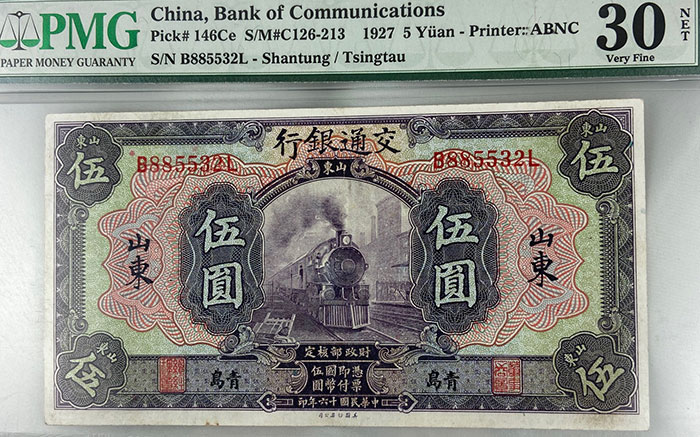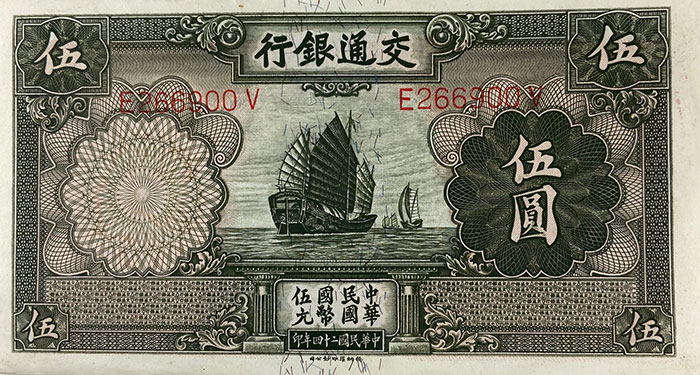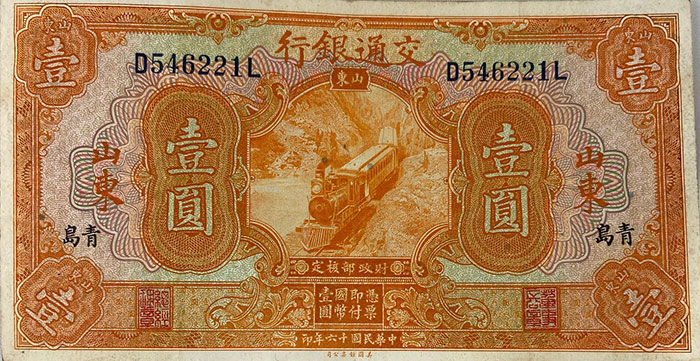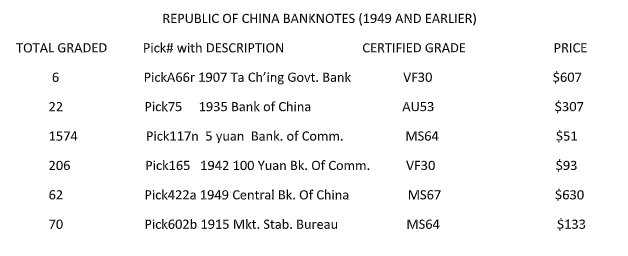Collecting Rare Pre-1950 Chinese Currency by Dr. Richard S. Appel – UniqueRareCoins.com ……
Part I | Part II | Part III | Part IV | Part V
* * *
Many factors converge to create the attraction and desirability of pre-1950 Chinese currency to worldwide collectors, investors, and history enthusiasts. This is especially true of the notes issued by the Bank of Communications (BofComm). One such reason is the bank’s rich history that is intertwined with the influence of various governments that ruled China early in its post-Monarch existence.
Of great note, many of their banknotes are far rarer–with some being exceedingly rare–than one would expect. Yet in my opinion, their emissions are presently underappreciated and undervalued. Importantly for English-speaking collectors and investors, English inscriptions and titles are used on the vast majority of Republic of China (ROC; 1912-1949) banknotes, including those from the BofComm.

The surprising rarity of these banknotes is attributed to the Mao Zedong-led Communist takeover of mainland China. This occurred after the 1949 culmination of China’s long, bloody Civil War. That single event rendered worthless the Bank of Communications and all other circulating Chinese banknotes.
When the Communists assumed power, they canceled the banknotes used by the millions upon millions of Chinese citizens. The public’s reaction to their loss was the wanton and mass destruction of the currency they heretofore depended upon for their daily purchases as well as their savings and their future. Both common and scarce banknotes were indiscriminately burned, buried, discarded, and otherwise destroyed when they became worthless to their owners. Countless millions of banknotes–and in some cases virtually all members of certain issues–were destroyed. Those that remain represent but a small percentage of what once existed.
The Creation of the Bank of Communications
The Bank of Communications began its existence in 1908 as a quasi-national bank, the General Bank of Communications. “Communications” referred to its purpose, which was to finance various forms of transportation and communication (such as ship or rail) that connected different locations with one another.


The bank was originally organized by a combination of private money and funds from the ruling Ch’ing Dynasty (1644-1912). Its initial transaction was to repurchase the Beijing-Hankow Railway from its current foreign owners. The bank survived the 1911-12 Revolution that resulted in the overthrow of the monarchy and established the Republic of China. Shortly thereafter it was renamed The Bank of Communications.
The surviving bank issued its first banknotes in 1912 and continued through 1942. Although today the bank continues to operate domestically and worldwide, its early years are steeped with intrigue.
Through its initial decades of operation, it was involved in various political actions that not only threatened its existence but also caused it to periodically suspend payments.
Their first scheme was their financing of Yuan Shih-kai’s failed attempt to reinstate the monarchy with himself as emperor. Today the bank has over 3,000 domestic banking outlets in over 80 major and numerous smaller Chinese cities. It is represented in over 20 foreign countries and is a worldwide employer of nearly 100,000 people. Its banknotes display many fascinating designs that are widely sought by collectors.
When Chiang Kai-shek gained leadership of the ROC Government in 1927, it was made a National Bank joining the Bank of China. One year later the Central Bank of China became the third and primary government bank. Almost immediately, Chiang initiated what was to become a 20-year brutal war with the Chinese Communist Party. The culmination of the war and the cancellation of all previous currency by the victorious Communists left the Chinese populace poverty-stricken.
Chinese Banknotes Far More Widely Collected Than Most Realize
The Population Report of the Paper Money Guarantee (PMG) banknote grading company shows the great popularity of Chinese banknotes among worldwide collectors and investors. PMG is the leading service grading the world’s currencies with over 15 years of experience. They have certified five million banknotes. The United States is extremely popular, as one would expect, but the U.S. is only the second most highly collected country. Currently, PMG has certified fewer than 800,000 American banknotes yet they have certified and authenticated over 2.1 million Chinese notes – the global leader by far.

There are a growing number of Chinese currency collectors. I believe as China’s economy further develops, more of its countrymen will become increasingly affluent. This will give them more free time and available funds to devote to collecting mementos representing their heritage. Their early paper money is one such example. Throughout history, this pattern has repeatedly occurred as different countries rose in global stature. As more collectors find this market, I anticipate the new demand will place increasing pressure on the limited supply of Bank of Communications and other early banknotes.
A Value Comparison Between ROC (1912-1949) and PRC (1948-Present) Banknotes
Presently, the People’s Republic of China currency (PRC-1948 to present) issued by the victorious Communists is enormously popular among the collecting Chinese. This is especially true for the numerous early issues.
Massive inflation occurred during the waning years of the Republic. This resulted because their primary funding of the war against the Communists was with the printing press. In June 1937, 3.7 yuan would buy one U.S. Dollar. By May 1949, it took 23.3 million yuan to purchase a single U.S. Dollar. Yes, 23.3 million!
Despite winning the war, the People’s Republic of China did not fare much better as inflation continued to build. They issued their first currency in 1948 to similarly help fund the war. By 1955, damaging inflation forced them to devalue and withdraw their early currency from circulation; they issued one new yuan for 10,000 of the old. In a similar fashion as the Republic banknotes, canceling their early notes created a scarcity of the remaining ones. Due to the great current demand for them by Chinese collectors, they sell for many multiples of Republic banknotes of similar scarcity.
Some recent eBay auction results will highlight what I view as a great price disparity between the pre-Communist banknotes (1949 and earlier) and the widely collected Communist notes; 1948-1954. I have listed the PMG Population Report totals for each note:


Prices for the Communist PRC notes have exploded in price during the past dozen years while those of the Republic of China and Bank of Communication notes have not. This is not to say the Communist banknotes are overpriced. However, I feel that the enormous disparity created between price and rarity will close. This will benefit the surviving Republic of China banknotes as the great values offered by them become increasingly obvious to the collecting and investing public.
* * *
About Dr. Richard Appel
Dr. Richard S. Appel has been a numismatic expert for 50 years. He offers his personal services as a rare coin broker or rare coin consultant to both beginner and experienced consumers alike. Please visit, or contact him at his website www.uniquerarecoins.com. He can also be reached by phone at (800) 782-2646. For a modest fee he will treat every purchase or sale of your coins as if they were his own, and will negotiate the best possible prices on your behalf.
中国, 中國, 中国银行股份有限公司, 中國銀行, 中国银行, 中行





I have Chinese banknotes from 1941 and want to sell them
You mention the “wonton and mass destruction” of pre-Communist currency. Even though you are discussing China, I think you meant “wanton.”